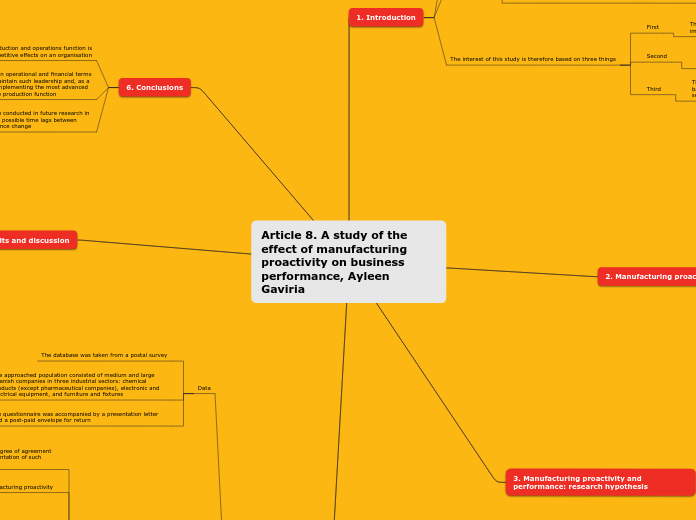da AYLEEN MELISSA GAVIRIA GUTI€RREZ mancano 5 anni
230
Article 8. A study of the effect of manufacturing proactivity on business performance, Ayleen Gaviria

da AYLEEN MELISSA GAVIRIA GUTI€RREZ mancano 5 anni
230

Più simili a questo
The industrial sector – which required the introduction of two binary variables distinguishing the chemical and electronic and electrical equipment sectors, respectively
The electronic sector concentrates the largest companies with the newest equipment and the highest levels of technical proactivity
Company internationalisation – included by using a binary variable distinguishing those companies which are part of multinational groups
The companies belonging to international groups tend to be the larger and more proactive companies
Plant equipment age – measured by the number of five-year intervals from the acquisition of the main productive equipment in use
Company size – measured as hundreds of employees
Managers marked on a five-point scale whether they considered their companies very inferior
Very superior
Somewhat superior
Equivalent
Somewhat inferior
Very inferior
In the Varimax orthogonal rotation
The second factor
mainly takes in practices that involve the adoption of concrete tools or techniques in the production plant as
JIT systems characterises those companies with high scores on factor 2
advanced manufacturing technologies
integrated information systems
CAD/CAM systems
It measures a technical dimension
The first factor
It implies a greater cultural change within the organisation and a high score on this factor means
that the company thinks of employees as resources instead of costs, considers their suppliers as collaborators rather than competitors, and promotes dynamism and continuous improvement
It measures a cultural dimension of manufacturing proactivity
The underlying manufacturing proactivity
It was performed, which capture 49.498 percent of the variance
each company was asked to choose their degree of agreement with ten assertions referring to the implementation of such practices
Manufacturing proactivity, involvement of the production function in strategic processes, and alignment between production capabilities and strategic objectives
Hayes and Wheelwright (1984) distinguish four stages in the evolution of manufacturing’s strategic role
In stage IV, externally supportive, the production function constitutes a fundamental mainstay of the business strategy and is involved in major strategic decisions topic
Those companies showing a higher degree of production proactivity are probably in stage IV or close to this stage. In fact, in what can be interpreted as production proactivity
In stage III, internally supportive, a production strategy is developed in order to support the business strategy
In stage II, externally neutral, some modifications are introduced in the production function in order to, at least, not harm the business strategy
In stage I, internally neutral, the production function is considered as a necessary burden that is difficult to change
Advanced manufacturing practices and business performance
The implementation of innovative work practices
involvement through problem-solving teams
employee participation
include employee training
It is through the literature
the degree of commitment to a long-term programme of investments in manufacturing structure and infrastructure aimed at building capabilities in anticipation of their need.
the degree of involvement of manufacturing in the strategic processes of the business unit
This research combines subjective measures of performance based on perceptions with objective data obtained from secondary sources.
This paper raises different causal explanations of the relationship between manufacturing proactivity and performance
The paper explores the behavioural dimensions underlying the implementation of advanced production practices